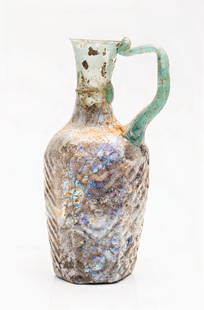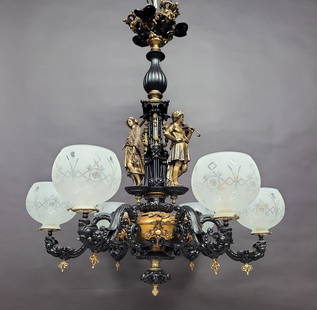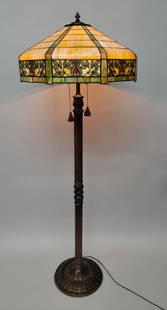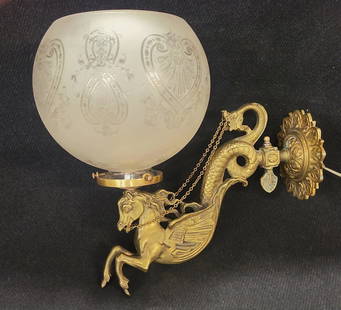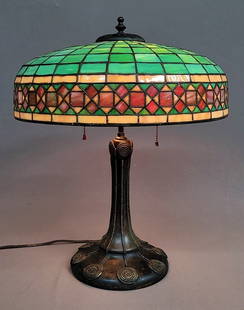

 Discovery- InteriorsBonhamsSponsored.Your ad here?
Discovery- InteriorsBonhamsSponsored.Your ad here?



Discovery- Interiors
Bonhams
Sponsored.Your ad here?


 Discovery- InteriorsBonhamsSponsored.Your ad here?
Discovery- InteriorsBonhamsSponsored.Your ad here?



Discovery- Interiors
Bonhams
Sponsored.Your ad here?

Greek Hellenistic Core-Formed Glass Alabastron
Similar Sale History
View More Items in Tableware & BarwareRelated Tableware & Barware
More Items in Tableware & Barware
View MoreRecommended Home & Décor
View More





Item Details
Description
Ancient Greece, Hellenistic Period, ca. mid 2nd to early 1st century BCE. A beautiful core-formed glass alabastron, so-named because many vessels that assumed this form were made of alabaster. The opaque vessel is comprised of dark-blue glass with yellow and light-blue marvered trailing which is combed into a feathered design to adorn the walls, and elegant spirals trace around the conical base and slender neck just below the discoid rim. The petite lug handles applied to each side of the neck are formed from solid dark-blue glass. Custom museum-quality display stand included. Size: 1.5" W x 4.75" H (3.8 cm x 12.1 cm); 5.7" H (14.5 cm) on included custom stand.
The alabastron is a long-bodied vessel with a rounded bottom, a cylindrical neck, and a flat disk for a mouth. Though usually without handles, some alabastra have eyes or lugs, like this example. According to the Beazley Archive of the University of Oxford, the alabastron shape's history extends back to Corinth, but was only preserved in Athenian pottery examples back to the mid-sixth century BCE. Alabastra were created in many materials, including alabaster, and the Greek term for this stone - alabastron (most likely of Egyptian origin) - was the source of inspiration for the name of this shaped vessel. Many examples were finished with a white ground, as if to imitate this stone. We know from vase painting imagery of women using alabastra following a bath, that these vessels most likely held perfumed oils.
According to the Corning Museum of Glass, core forming is "the technique of forming a vessel by winding or gathering molten glass around a core supported by a rod. After forming, the object is removed from the rod and annealed. After annealing, the core is removed by scraping." (https://www.cmog.org/glass-dictionary/core-forming). This process of glass making was begun in the late 16th century BCE by glassmakers of Mesopotamia, and then adopted by Egyptian glassmakers in the 15th century BCE. The technique almost came to an end in the so-called Dark Ages of Mediterranean civilization (1200 to 900 BCE); however, by the 9th century BCE a new generation of glassmakers took up the technique once again, and between the 6th and 4th century BCE core-forming spread throughout the Mediterranean.
A stylistically-similar, slightly-smaller example with a different tooling pattern hammered for $10,625 at Christie's, New York Antiquities Auction (sale 2856, June 5, 2014, lot 42): https://www.christies.com/lotfinder/ancient-art-antiquities/an-eastern-mediterranean-core-formed-glass-alabastron-circa-5800553-details.aspx?from=searchresults&intObjectID=5800553&sid=9bcf1355-aa4a-4657-9525-61e888d9c2ba
Provenance: private East Coast, USA collection; ex-private S. K. Heninger collection, North Carolina, USA, acquired in the 1970s
All items legal to buy/sell under U.S. Statute covering cultural patrimony Code 2600, CHAPTER 14, and are guaranteed to be as described or your money back.
A Certificate of Authenticity will accompany all winning bids.
We ship worldwide to most countries and handle all shipping in-house for your convenience.
#137699
The alabastron is a long-bodied vessel with a rounded bottom, a cylindrical neck, and a flat disk for a mouth. Though usually without handles, some alabastra have eyes or lugs, like this example. According to the Beazley Archive of the University of Oxford, the alabastron shape's history extends back to Corinth, but was only preserved in Athenian pottery examples back to the mid-sixth century BCE. Alabastra were created in many materials, including alabaster, and the Greek term for this stone - alabastron (most likely of Egyptian origin) - was the source of inspiration for the name of this shaped vessel. Many examples were finished with a white ground, as if to imitate this stone. We know from vase painting imagery of women using alabastra following a bath, that these vessels most likely held perfumed oils.
According to the Corning Museum of Glass, core forming is "the technique of forming a vessel by winding or gathering molten glass around a core supported by a rod. After forming, the object is removed from the rod and annealed. After annealing, the core is removed by scraping." (https://www.cmog.org/glass-dictionary/core-forming). This process of glass making was begun in the late 16th century BCE by glassmakers of Mesopotamia, and then adopted by Egyptian glassmakers in the 15th century BCE. The technique almost came to an end in the so-called Dark Ages of Mediterranean civilization (1200 to 900 BCE); however, by the 9th century BCE a new generation of glassmakers took up the technique once again, and between the 6th and 4th century BCE core-forming spread throughout the Mediterranean.
A stylistically-similar, slightly-smaller example with a different tooling pattern hammered for $10,625 at Christie's, New York Antiquities Auction (sale 2856, June 5, 2014, lot 42): https://www.christies.com/lotfinder/ancient-art-antiquities/an-eastern-mediterranean-core-formed-glass-alabastron-circa-5800553-details.aspx?from=searchresults&intObjectID=5800553&sid=9bcf1355-aa4a-4657-9525-61e888d9c2ba
Provenance: private East Coast, USA collection; ex-private S. K. Heninger collection, North Carolina, USA, acquired in the 1970s
All items legal to buy/sell under U.S. Statute covering cultural patrimony Code 2600, CHAPTER 14, and are guaranteed to be as described or your money back.
A Certificate of Authenticity will accompany all winning bids.
We ship worldwide to most countries and handle all shipping in-house for your convenience.
#137699
Condition
Professionally repaired from multiple large pieces with some small chips and light adhesive residue along break lines. Surface wear and minor abrasions commensurate with age, small nicks to body, handles, and rim, with light fading to pigmentation. Nice earthen deposits throughout.
Buyer's Premium
- 24.5%
Greek Hellenistic Core-Formed Glass Alabastron
Estimate $3,500 - $5,000
6 bidders are watching this item.
Shipping & Pickup Options
Item located in Louisville, CO, usSee Policy for Shipping
Payment

TOP





















